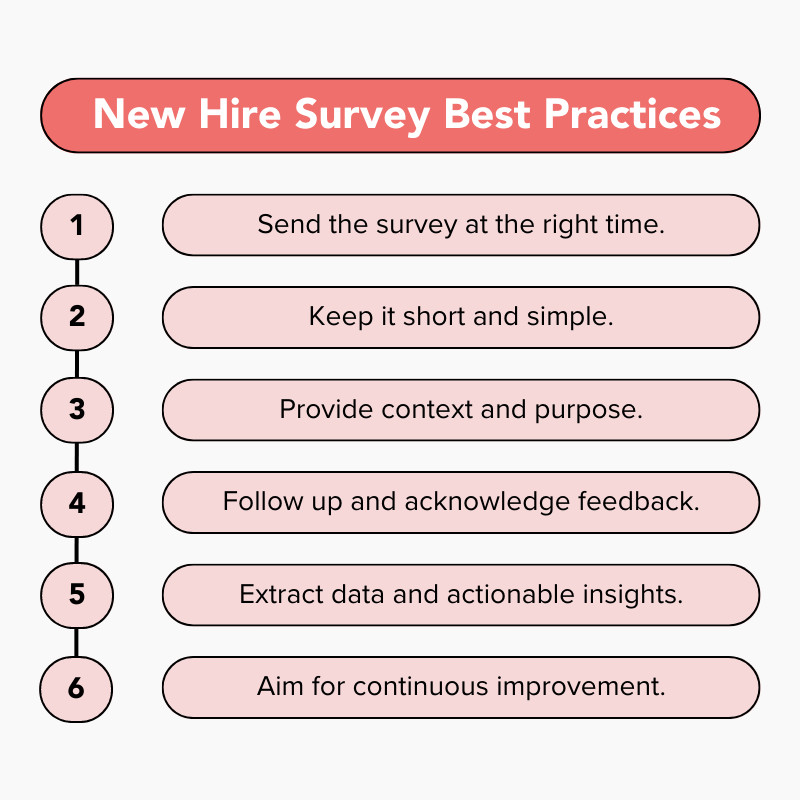Did you know that effective onboarding helps new hires feel eighteen times more committed to their employer compared to employees who felt their onboarding was less effective? Furthermore, 69% of employees say that they are more likely to stay with a company for three years if they experience great onboarding.
The first few weeks and months of a new hire’s experience are crucial. This is why it’s important for HR leaders to optimize the onboarding process to create a seamless transition for new team members. But simply implementing a few best practices isn’t enough. HR leaders must be able to measure their strategy’s effectiveness, make adjustments when needed, and seek to fine-tune the process.
One powerful tool that can make a significant difference in how your organization approaches this phase is the new hire survey.
What is a new hire survey?
A new hire survey is a type of feedback mechanism that captures the experiences and impressions of recently onboarded employees. It serves as a vital channel for new hires to express their thoughts, concerns, and suggestions about the onboarding process and their initial days at the company.
The importance of new hire surveys
New hire surveys offer several key benefits to both organizations and their employees. For organizations, they provide crucial data to improve the onboarding process, ultimately leading to increased employee satisfaction, engagement, and retention. By addressing pain points and enhancing the onboarding experience, companies can minimize early turnover and set a positive tone for the entire employee lifecycle.
For employees, new hire surveys give a voice to their experiences, concerns, and suggestions. It allows them to feel heard and valued from the start, increasing their sense of belonging and commitment to the organization.
Why overpay for employee feedback?
Understand your employee experience at every step of their journey from onboarding to exit with JobSage Retain— all for an affordable $100 per month.
Example new hire survey questions
Crafting effective survey questions is essential to gather meaningful feedback from new employees. The questions should be clear, concise, and targeted to specific aspects of the onboarding process. Here are some key questions to include in your new hire survey:
Onboarding process evaluation
- How satisfied are you with the overall onboarding process?
- Were the onboarding steps and timelines clearly communicated to you?
- How well did the onboarding process align with your expectations before joining the organization?
- Were there any specific onboarding activities or events that stood out to you as particularly helpful or enjoyable?
Orientation and training
- Did the orientation adequately introduce you to the organization’s culture, values, and mission?
- Was the training provided relevant to your role and responsibilities?
- Were there any aspects of the training that you found challenging or confusing?
Job expectations
- Do you feel you have a clear understanding of your job expectations and performance objectives?
- Were your job responsibilities and tasks clearly defined?
- Did you receive adequate support and tools to help you meet your job expectations during the onboarding period?
- Were there any discrepancies between the job description and the actual responsibilities assigned to you?
Integration and team dynamics
- Do you feel welcome and supported by your colleagues and immediate supervisor?
- Did you have the opportunity to interact with team members and colleagues from different departments during the onboarding process?
- Were there any team-building activities or initiatives that you found beneficial in fostering a sense of camaraderie?
Resources and support
- Did you have access to the necessary tools and resources to perform your job effectively?
- Were there any challenges or obstacles that hindered your productivity during the onboarding process?
- How well were you informed about the resources and support available to you for ongoing learning and development?
- Were there any specific tools or resources that you believe would have enhanced your onboarding experience if provided?
Communication and feedback
- Were communication channels with your manager and HR easily accessible?
- Did you receive regular feedback and guidance during the onboarding period?
- Did you have regular check-ins with your manager or mentor to discuss your progress and address any concerns?
- Were there any instances where you felt communication could have been improved?
Facilities and work environment
- How would you rate the workplace facilities and work environment?
- Is there anything specific that could be improved to enhance the work atmosphere?
- Did you find the physical workspace conducive to productivity and collaboration?
- Were there any aspects of the office environment that you would like to see improved?
Expectations vs. reality
- Did the actual job and work environment meet your expectations based on the pre-hire communication and interviews?
- Is there anything you wish you had known before starting the job?
- Did your initial impression of the organization and its work culture change after going through the onboarding process?
- Were there any surprising aspects of the job or company that you didn’t anticipate?
Recommendations
- Based on your onboarding experience, would you recommend this organization to a friend or colleague as a great place to work?
- If you could change one thing about the onboarding process, what would it be, and why?
- What advice would you give to future new hires to make the most out of their onboarding experience?
Additional feedback
- Is there any other feedback or suggestions you would like to share to improve the onboarding process for future new hires?

New hire survey best practices
To make the most of new hire surveys and harness their potential in shaping a successful onboarding experience, HR professionals should follow a set of best practices. These strategies, ranging from optimal timing to actionable data analysis, ensure that new hire surveys become powerful tools for gathering meaningful feedback.
1. Send the survey at the right time.
Sending the new hire survey at the right time is crucial to gather relevant feedback. Ideally, wait until new hires have had enough time to settle into their roles and get acclimated to the organization’s culture.
However, don’t wait too long, as their initial experiences might fade from memory.
Consider conducting follow-up surveys at various intervals, such as after the first week, first month, and first quarter, to capture ongoing feedback and identify any changes in sentiment over time.
2. Keep it short and simple.
Your new hire survey should be concise and focused to avoid overwhelming participants. Surveys should be no more than ten questions and take no more than fifteen minutes to complete. A that is too long may deter new hires from completing it thoroughly.
Utilize a mix of question formats, including rating scales and open-ended questions. This approach allows for a combination of quantitative and qualitative feedback, providing a more comprehensive view of new hires’ experiences.
3. Provide context and purpose.
Clearly explain the purpose of the survey to new hires and how their feedback will be used to improve the onboarding experience. When employees understand the significance of their input, they are more likely to engage thoughtfully in the survey. Emphasize that their feedback is valued and will contribute to shaping future onboarding practices, fostering a sense of ownership in the process.
4. Follow up and acknowledge feedback.
After sending out the survey, acknowledge the receipt of responses and thank new hires for their participation. Providing feedback acknowledgment shows that their voices are heard and valued by the organization. Consider sharing— both with recent hires and your entire team— key takeaways and planned improvements based on the feedback to demonstrate that their input is being taken seriously and acted upon.
5. Extract data analysis and actionable insights.
After you collect survey responses, analyze the data systematically. Identify trends, common themes, and specific areas that need improvement. Prioritize action items based on the feedback received and develop actionable strategies to address identified concerns. This approach ensures that the feedback gathered is used effectively to drive meaningful changes.
6. Aim for continuous improvement.
Treat new hire surveys as an ongoing process rather than a one-time event. Continuously refine the survey questions and process to capture the evolving needs and expectations of new hires. Regularly review and update the onboarding program based on the feedback received and lessons learned from each survey cycle. A commitment to continuous improvement ensures that the onboarding process remains responsive to the changing needs of the organization and its employees.
Ready for actionable insights from your new hires?
Get data that makes a difference with JobSage Retain. With our expert-built New Hire Survey template, it’s never been easier!
Start on the right foot
New hire surveys serve as powerful tools to gain insights and feedback during the critical onboarding phase. By asking well-crafted questions, assuring anonymity, and acknowledging feedback, HR professionals can optimize the survey process and make data-driven improvements to the onboarding experience. Emphasizing continuous improvement and valuing employee input will lead to a more engaged, productive, and loyal workforce, laying the foundation for long-term organizational success.
